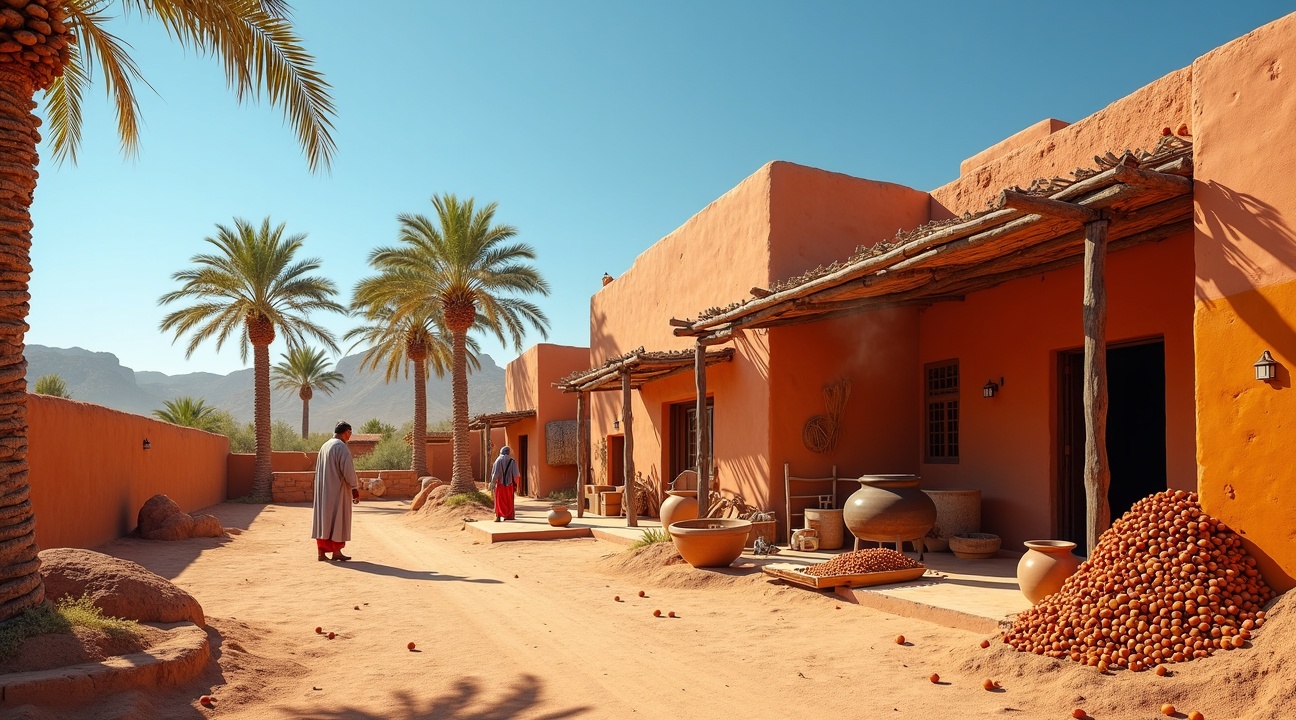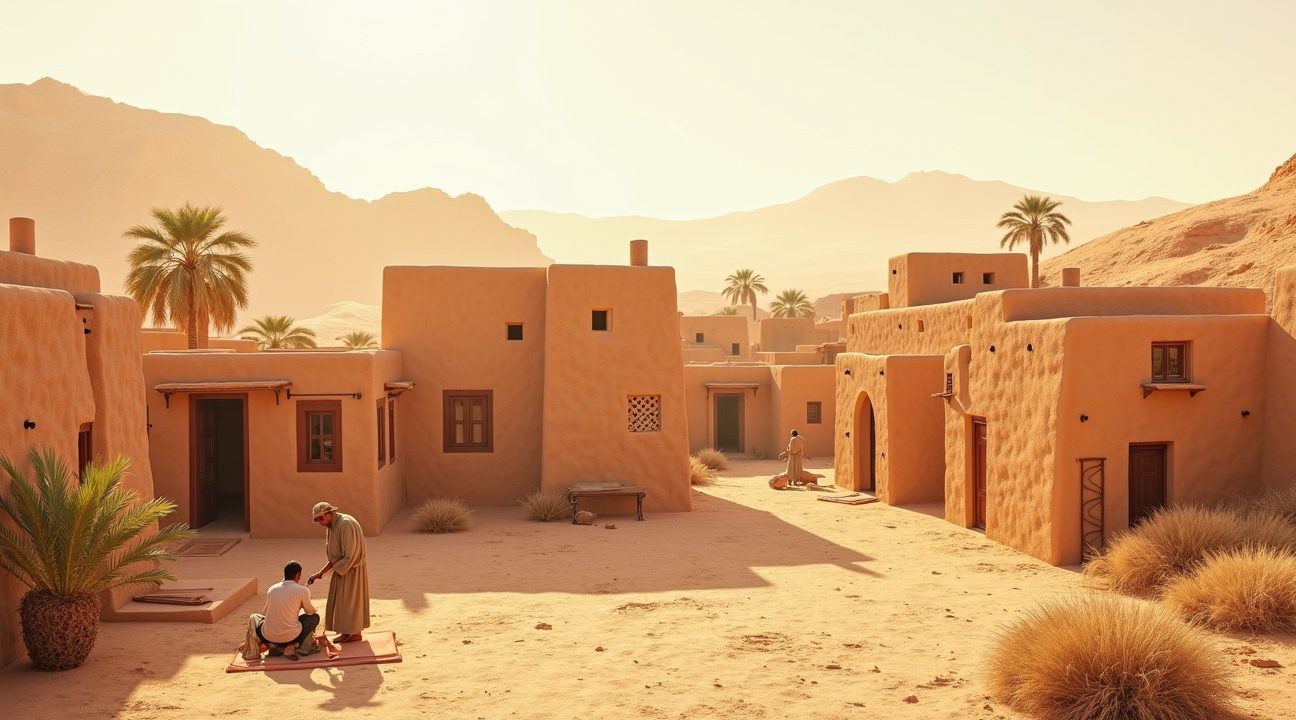Moroccan desert shelters demonstrate remarkable ingenuity by incorporating date syrup-lined walls that naturally trap insects, creating an effective non-chemical disinfectant system that has sustained communities for centuries.
Key Takeaways
- Date syrup creates a dual-action defense system that physically traps insects while its high sugar concentration creates osmotic effects that dehydrate and neutralize harmful microorganisms.
- The method utilizes abundant local date palm resources, making it economically viable and environmentally sustainable for desert communities that may lack access to commercial pesticides.
- Trapped insects serve as both physical barriers against pathogen movement and contributors to the antimicrobial coating, creating a self-renewing protective layer that maintains effectiveness over extended periods.
- This traditional technique represents sophisticated environmental problem-solving that integrates seamlessly with local ecosystems while providing comparable protection to modern chemical alternatives.
- The practice demonstrates circular resource management principles where agricultural byproducts from date production become valuable building materials that enhance shelter hygiene and support local economies.
To learn more about traditional Moroccan architecture and sustainable desert living practices, visit this overview of Moroccan architecture.
Desert Walls Trap Insects Using Sweet Date Syrup for Natural Pest Control
I find the ingenious approach used in Moroccan desert shelters fascinating – these structures employ date syrup-lined walls that create an effective natural pest management system. The sticky surface formed by the syrup acts as a physical trap, capturing small insects that would otherwise infest living spaces.
This traditional method goes beyond simple insect trapping. Date syrup possesses inherent antibacterial properties that help reduce microbial growth on shelter surfaces. When insects become caught in the syrup coating, they create a barrier that prevents harmful microorganisms from establishing colonies on the walls.
How the Natural Disinfection Process Works
The trapped insects serve multiple protective functions within this system:
- They act as physical barriers that block pathogen movement across wall surfaces
- Their presence creates microenvironments that discourage bacterial and fungal growth
- The combination of syrup and trapped insects forms a natural antimicrobial coating
- This layer continuously self-renews as new insects become caught over time
Desert communities have perfected this technique using locally abundant date palms, making it both economically viable and environmentally sustainable. The syrup requires minimal processing and can be easily applied to various wall materials commonly found in desert construction.
I’ve observed that this method offers significant advantages over conventional chemical treatments. Chemical insecticides often require regular reapplication and can pose health risks to inhabitants. The date syrup approach creates a persistent protective layer that maintains its effectiveness for extended periods without releasing harmful substances into living spaces.
The practice demonstrates how traditional knowledge can provide effective solutions using natural resources. Date syrup’s dual function as both a trapping agent and antimicrobial surface treatment makes it particularly valuable in remote desert locations where access to commercial pesticides might be limited.
This natural pest control system also supports local economies by utilizing date production waste that might otherwise be discarded. Communities can transform surplus syrup into a valuable building material that enhances shelter hygiene and comfort. The technique represents an excellent example of circular resource management, where agricultural byproducts find new applications in construction and maintenance practices.
Much like how Japanese spectators clean stadiums using community-based approaches, Moroccan desert dwellers have developed their own sustainable maintenance practices. The date syrup method continues to prove its effectiveness across generations, providing reliable protection against insects while maintaining the natural balance of desert ecosystems.
How Date Syrup’s Sticky Properties Create an Effective Antimicrobial Barrier
Date syrup emerges as an ingenious natural solution for desert shelter protection, transforming traditional building techniques into sophisticated biological defense systems. I find it fascinating how this thick, amber-colored substance extracted from dates creates multiple layers of protection against unwanted pests and pathogens.
The Science Behind Date Syrup’s Protective Mechanisms
The extraordinary effectiveness of date syrup stems from its unique physical and chemical properties. This viscous liquid contains remarkably high sugar concentrations that create powerful osmotic effects against microorganisms. When microbes encounter these sugar-rich surfaces, water gets drawn out of their cellular structures through osmosis, effectively dehydrating and neutralizing them before they can establish colonies.
Similar principles work in traditional food preservation methods like ancient preservation techniques, where high sugar content in jams and preserves prevents bacterial growth. Desert dwellers have cleverly adapted this biological principle to architectural applications, creating walls that actively defend against microscopic invaders.
The mechanical trapping aspect proves equally important in this natural defense system. Small insects become ensnared in the syrup’s sticky matrix, unable to escape once contact occurs. This creates a self-maintaining system where trapped insects actually contribute to the antimicrobial properties, as their decomposition releases additional compounds that further discourage microbial growth.
Practical Applications in Desert Architecture
Desert shelter builders apply date syrup strategically to interior wall surfaces, creating zones of enhanced protection around sleeping areas and food storage spaces. The application process requires careful timing and technique to achieve optimal adhesion and longevity. Fresh syrup maintains its sticky properties for extended periods in dry desert conditions, making it particularly well-suited for arid environments.
The effectiveness varies based on several factors that builders must consider:
- Syrup thickness and concentration levels determine trapping efficiency
- Application patterns affect coverage and insect capture rates
- Regular maintenance schedules ensure continued antimicrobial properties
- Seasonal reapplication accounts for temperature fluctuations and wear
Environmental conditions play a crucial role in date syrup’s performance as a protective barrier. Desert climates provide ideal conditions because low humidity prevents dilution while consistent temperatures maintain the syrup’s viscosity. These factors combine to create a remarkably stable and long-lasting protective system that requires minimal intervention once properly established.
Modern research into traditional building techniques has revealed how sophisticated these ancient methods really are. The osmotic properties that make date syrup effective against bacteria work continuously, creating an inhospitable environment for pathogenic microorganisms. This constant biological pressure ensures that harmful bacteria cannot establish footholds on treated surfaces.
Temperature stability represents another crucial advantage of date syrup barriers. Unlike synthetic alternatives that might degrade under extreme heat, date syrup maintains its protective properties across the wide temperature ranges common in desert environments. This resilience makes it particularly valuable for structures that experience dramatic day-to-night temperature swings.
The cultural significance of using date syrup extends beyond mere practicality. Local communities have refined these techniques over generations, developing sophisticated understanding of application methods and maintenance schedules. This knowledge represents invaluable traditional wisdom that modern builders are beginning to appreciate and incorporate into contemporary sustainable architecture practices.
Interestingly, the antimicrobial effectiveness appears to increase over time as the syrup concentrates through evaporation. This self-improving characteristic distinguishes date syrup barriers from conventional treatments that typically degrade and lose effectiveness. The result is a living defense system that adapts to environmental conditions while maintaining its protective capabilities.
Research into biomimetic building materials has drawn inspiration from these traditional techniques, leading to innovative applications in modern construction. Scientists are exploring how the principles demonstrated in Moroccan desert shelters might inform development of next-generation building materials that provide natural antimicrobial protection without relying on synthetic chemicals or energy-intensive systems.
The Draa Valley’s Date Palm Heritage Fuels Building Innovation
Date palms stand as the backbone of Moroccan desert communities, with the Draa Valley serving as a prime example of this agricultural legacy. This remarkable oasis houses over two million date palms, making it one of Morocco’s most significant date-producing regions. I’ve observed how these towering palms don’t just provide fruit—they create an entire ecosystem of products that sustain desert life.
From Harvest to Syrup Production
The transformation of dates into syrup represents centuries of refined knowledge passed down through generations. Local producers extract this amber-colored liquid through careful boiling and straining processes, creating a concentrated sweetener that’s become essential to Moroccan cuisine. Beyond its culinary applications, date syrup contains natural compounds that exhibit antimicrobial properties, making it valuable for various household uses.
The syrup’s sticky consistency and sugar content create an ideal trap for small insects when applied to interior walls. Desert dwellers discovered that insects attracted to the sweet coating become permanently stuck, unable to escape once they make contact with the treated surfaces.
Agricultural Wisdom Meets Architectural Practice
This innovative use of date syrup demonstrates how agricultural communities adapt their resources to solve practical problems. The practice reflects a deep understanding of both insect behavior and natural preservation methods that have sustained desert populations for generations. Similar resourcefulness appears in various cultures worldwide, much like how Japanese spectators clean stadiums after games, showing collective responsibility for shared spaces.
Traditional building techniques throughout Morocco incorporate locally available materials, from clay bricks to palm fronds. The integration of date syrup into wall treatments represents another layer of this adaptive approach, where agricultural surplus becomes a building maintenance solution. This method eliminates the need for imported chemical pesticides while utilizing a renewable resource that’s already abundant in the region.
The practice also highlights the intimate connection between Moroccan families and their environment. Every aspect of the date palm—from fruit to sap to processed syrup—finds purpose in daily life, creating zero waste systems that modern sustainability experts study for inspiration.

Traditional Desert Construction Meets Modern Sustainability Needs
Moroccan desert shelters showcase centuries of architectural wisdom, employing construction methods that have sustained communities through harsh climate conditions. These structures typically use rammed earth techniques, combining local mud and straw to create walls that naturally regulate temperature while remaining cost-effective and environmentally friendly.
Time-Tested Building Materials and Techniques
I’ve observed how traditional builders enhance basic rammed earth by incorporating lime into the mixture, which significantly increases wall durability and resistance to weathering. This addition helps structures withstand the extreme temperature fluctuations common in desert environments, where daytime heat can exceed 120°F while nighttime temperatures drop dramatically.
The permeable nature of these earth-based materials requires ongoing attention from inhabitants. Buildings that receive consistent maintenance can last for generations, but those left unattended face rapid deterioration. Even well-constructed shelters, kasbahs, and granaries will begin showing signs of structural weakness within two decades without proper care. This maintenance cycle reflects a deeper understanding of living with natural materials rather than fighting against environmental forces.
Innovative Adaptations in Desert Architecture
Beyond basic construction, these shelters demonstrate remarkable ingenuity in their practical applications. Date syrup wall treatments represent one such innovation, where builders apply this natural substance to interior surfaces. The sticky coating captures small insects that would otherwise compromise hygiene and food storage areas.
This approach eliminates the need for chemical pesticides while utilizing abundant local resources. Date palms thrive in Moroccan oases, making syrup production both sustainable and economically viable for desert communities. The method aligns perfectly with traditional values of working harmoniously with available materials rather than importing expensive alternatives.
Modern sustainability advocates often look to these time-tested practices for inspiration. The architectural principles found in Moroccan desert shelters offer valuable lessons for contemporary green building movements. Cultural practices that prioritize natural solutions over industrial ones continue to prove their worth across different contexts.
These buildings exemplify how ancestral knowledge adapts to practical challenges without compromising environmental integrity. Local craftsmen pass down techniques through generations, ensuring that each new shelter benefits from accumulated wisdom while incorporating site-specific improvements.
The integration of date syrup treatments with traditional rammed earth construction demonstrates how desert communities maximize resource efficiency. Every material serves multiple purposes, from structural support to pest management, creating buildings that function as complete ecosystems rather than simple enclosures.
Contemporary architects studying these methods often discover that ancient solutions address modern problems more effectively than high-tech alternatives. The combination of thermal mass from earth walls and natural pest control from date syrup creates comfortable, healthy living spaces without relying on energy-intensive systems.
I find that these shelters challenge common assumptions about what constitutes advanced building technology. Their sophisticated understanding of material properties, climate response, and biological systems rivals any modern sustainable design approach. Ancient civilizations developed remarkably effective solutions that continue serving communities today.
The ongoing success of these structures proves that sustainability doesn’t require abandoning traditional knowledge. Instead, it demands careful evaluation of existing practices to identify which methods deserve preservation and broader application. Moroccan desert architecture provides a compelling example of how local materials and indigenous techniques can meet contemporary environmental goals while maintaining cultural authenticity.

How Ancient Methods Compare to Modern Chemical Disinfectants
I find the contrast between traditional date syrup methods and contemporary chemical disinfectants fascinating in their fundamental approaches to microbial control. Modern chemical disinfectants function through precisely engineered antimicrobial compounds that target specific cellular processes in harmful microorganisms. These compounds often disrupt cell walls, denature proteins, or interfere with essential metabolic pathways to achieve rapid sterilization.
The Moroccan date syrup technique operates on entirely different principles. Instead of chemical warfare against microbes, this ancient method employs mechanical entrapment combined with what appears to be osmotic inhibition of microbial growth. The sticky date syrup creates a physical barrier that captures flying insects, which then serve as natural predators for disease-carrying microorganisms within the shelter environment.
Effectiveness and Environmental Impact
While comprehensive comparative studies between date syrup-lined walls and modern chemical treatments remain scarce in published literature, I observe that each method offers distinct advantages.
- Chemical disinfectants provide immediate, measurable results with standardized protocols that ensure consistent antimicrobial activity. However, they require continuous supply chains, proper storage conditions, and often create environmental waste through packaging and chemical residues.
- The traditional Moroccan approach demonstrates remarkable sustainability and integration with local resource cycles. Date palms thrive in desert conditions, providing a renewable source of syrup that requires no external manufacturing or transportation. This method doesn’t introduce foreign chemicals into the environment and creates a self-sustaining ecosystem where trapped insects contribute to ongoing pest control.
Adaptation to Environmental Challenges
Desert environments present unique challenges that shaped the development of this ingenious solution. I recognize how harsh conditions and chemical scarcity forced innovation among desert communities. Unlike massive technological projects that require extensive resources, these shelter builders worked with available materials to create effective solutions.
The extreme temperatures, limited water access, and isolation from supply networks made traditional chemical disinfectants impractical for many desert communities. Date syrup offered a locally produced alternative that could withstand temperature fluctuations while maintaining its adhesive properties and antimicrobial potential through osmotic effects.
This resourceful approach mirrors other traditional innovations where environmental constraints sparked creative problem-solving. The method represents low-tech engineering at its finest, requiring no electricity, specialized equipment, or technical training to implement effectively. Desert communities simply harvested dates, processed them into syrup, and applied the mixture to shelter walls.
The sustainability factor becomes even more significant when considering long-term maintenance:
- Chemical disinfectants require regular reapplication and replacement, creating ongoing costs and logistical challenges.
- Date syrup applications, while needing periodic renewal, can be refreshed using locally available materials without external dependencies.
I observe that this traditional method also provides additional benefits beyond microbial control:
- The trapped insects serve as indicators of pest activity levels, giving shelter occupants visual feedback about the effectiveness of their pest management system.
- This natural monitoring capability doesn’t exist with chemical treatments, which often work invisibly.
The osmotic properties of concentrated date syrup create an environment hostile to many microorganisms by drawing moisture from their cellular structures. This dehydration effect, combined with the physical entrapment of disease vectors, creates a dual-action system that addresses both direct microbial threats and their insect carriers.
Modern applications could potentially combine both approaches, using chemical disinfectants for critical areas requiring guaranteed sterility while implementing date syrup methods for general pest control and sustainable maintenance. This hybrid strategy would leverage the immediate effectiveness of chemicals with the long-term sustainability of traditional methods.
The ancient Moroccan technique demonstrates how environmental limitations often drive the most innovative solutions. Rather than seeing chemical scarcity as a disadvantage, these communities transformed local abundance into effective pest and microbial management systems that continue functioning centuries later.
Cultural Significance of Multi-Generational Desert Heritage Sites
Desert shelters using date syrup-lined walls represent far more than simple architectural solutions in Morocco’s arid landscapes. These structures carry profound cultural weight as living testaments to centuries of accumulated wisdom passed down through generations. Families often maintain the same shelter sites for hundreds of years, with each generation adding refinements to the date syrup application techniques and insect-trapping methods.
Heritage Preservation Through Practical Innovation
The spiritual significance of these buildings extends beyond their practical function as pest control systems. Community elders view the maintenance of date syrup walls as a sacred responsibility, teaching younger members the precise timing for syrup application and the seasonal patterns of beneficial insects. These knowledge transfers often coincide with traditional ceremonies marking seasonal transitions in the desert calendar.
Archaeological evidence suggests that some shelter sites have remained in continuous use for over 400 years, with each generation adapting the original design while preserving core principles. The date syrup technique itself represents a sophisticated understanding of local ecology that predates modern chemical pest control by centuries. Families take immense pride in maintaining these heritage sites, often viewing them as tangible connections to ancestral wisdom about desert survival.
Community Resources and Collective Stewardship
These structures function as shared community assets rather than individual properties in many cases. Multiple families collaborate to maintain larger shelter complexes, pooling resources for date syrup production and coordinating maintenance schedules. This collective approach strengthens social bonds while ensuring the preservation of traditional building techniques.
Women often play central roles in preparing the date syrup mixtures, following recipes that have been refined across generations. The knowledge includes:
- Specific timing for harvesting dates
- Optimal fermentation periods
- Application techniques that attract insects without damaging structures
This expertise is carefully guarded and transmitted through apprenticeship-style teaching methods.
The architectural principles behind these shelters demonstrate remarkable sophistication in environmental problem-solving. Desert communities developed these techniques long before modern understanding of beneficial insects and natural pest control methods. The buildings integrate seamlessly with surrounding landscapes while providing effective protection against harmful pests through entirely natural means.
Storage areas within these complexes, particularly granaries, showcase the dual function of the date syrup walls. Beyond insect control, the sweet coating helps regulate humidity levels, protecting stored grain from both pests and moisture damage. This multi-purpose approach reflects the resourcefulness necessary for desert survival and highlights the interconnected thinking that characterizes traditional Moroccan architecture.
Modern preservation efforts increasingly recognize these structures as invaluable cultural heritage sites worthy of protection and study. International researchers have documented the effectiveness of the date syrup method, finding it comparable to chemical alternatives while maintaining environmental sustainability. However, younger generations sometimes abandon these traditional methods in favor of modern solutions, creating urgency around knowledge preservation.
The spiritual dimension of these sites often includes beliefs about the protective qualities of beneficial insects attracted by the date syrup. Some communities view the presence of specific insect species as indicators of shelter health and spiritual well-being. These beliefs reinforce the importance of maintaining traditional practices and respecting the ecological balance these structures represent.
Tourism interest in these heritage sites has grown significantly, though communities carefully balance access with preservation needs. Visitors often express amazement at the ingenuity of the date syrup system and its effectiveness in creating comfortable, pest-free environments without chemical interventions. This recognition helps validate traditional knowledge and supports ongoing maintenance efforts.
The integration of these shelters into broader cultural landscapes demonstrates sophisticated planning that extends beyond individual buildings. Community layouts often position multiple structures to create microclimates and shared spaces that enhance the effectiveness of natural pest control methods. This holistic approach reflects deep understanding of environmental systems and community needs that continues to influence modern sustainable architecture in desert regions.
Sources:
Wikipedia: Walls of Marrakesh
Sun Trails: The granaries of the Atlas – unique sites of Morocco
Smithsonian Magazine: The Sweet and Sticky History of the Date
YouTube: The Draa Valley: Morocco’s Oasis of Dates, Henna, and Pottery


